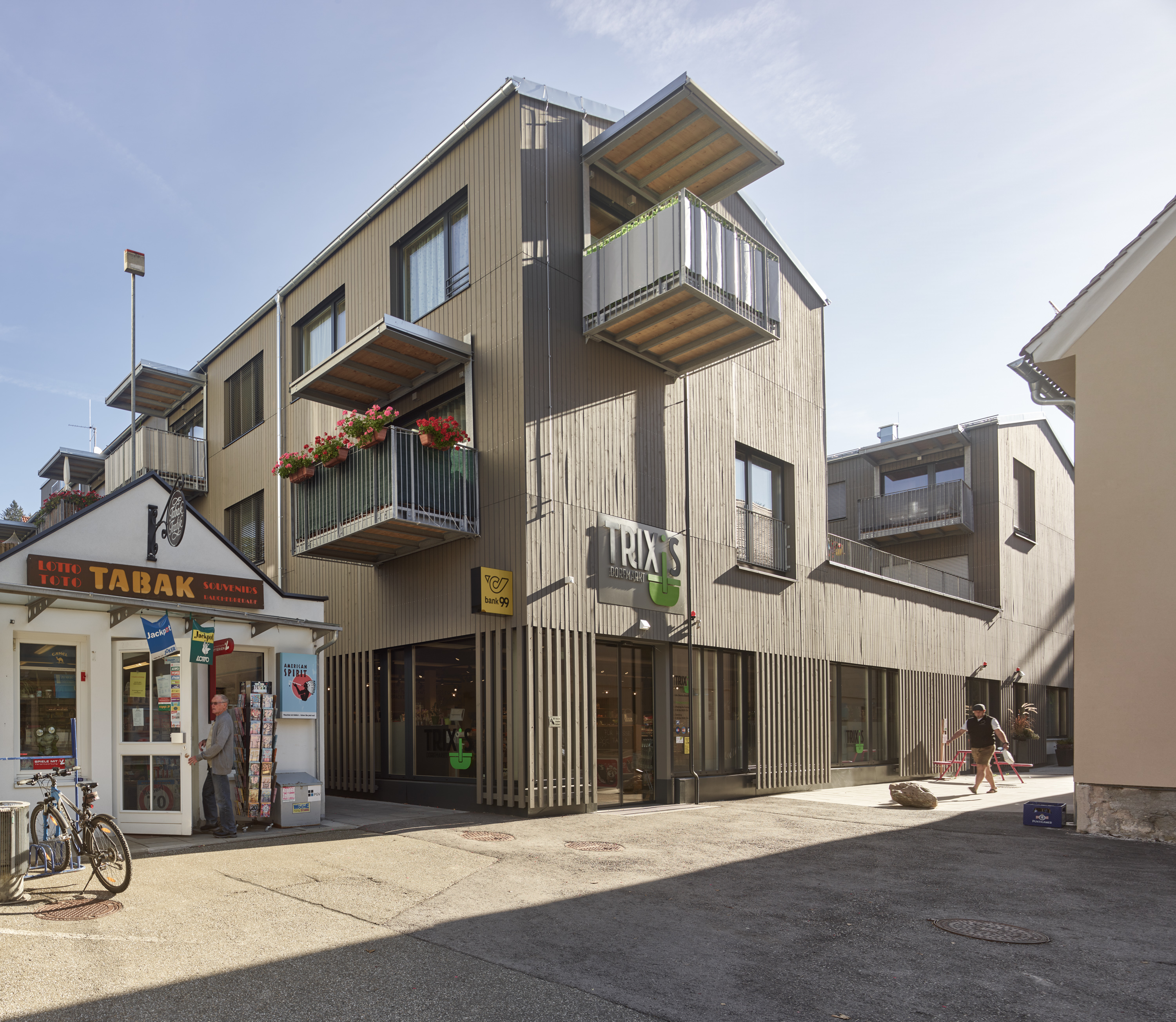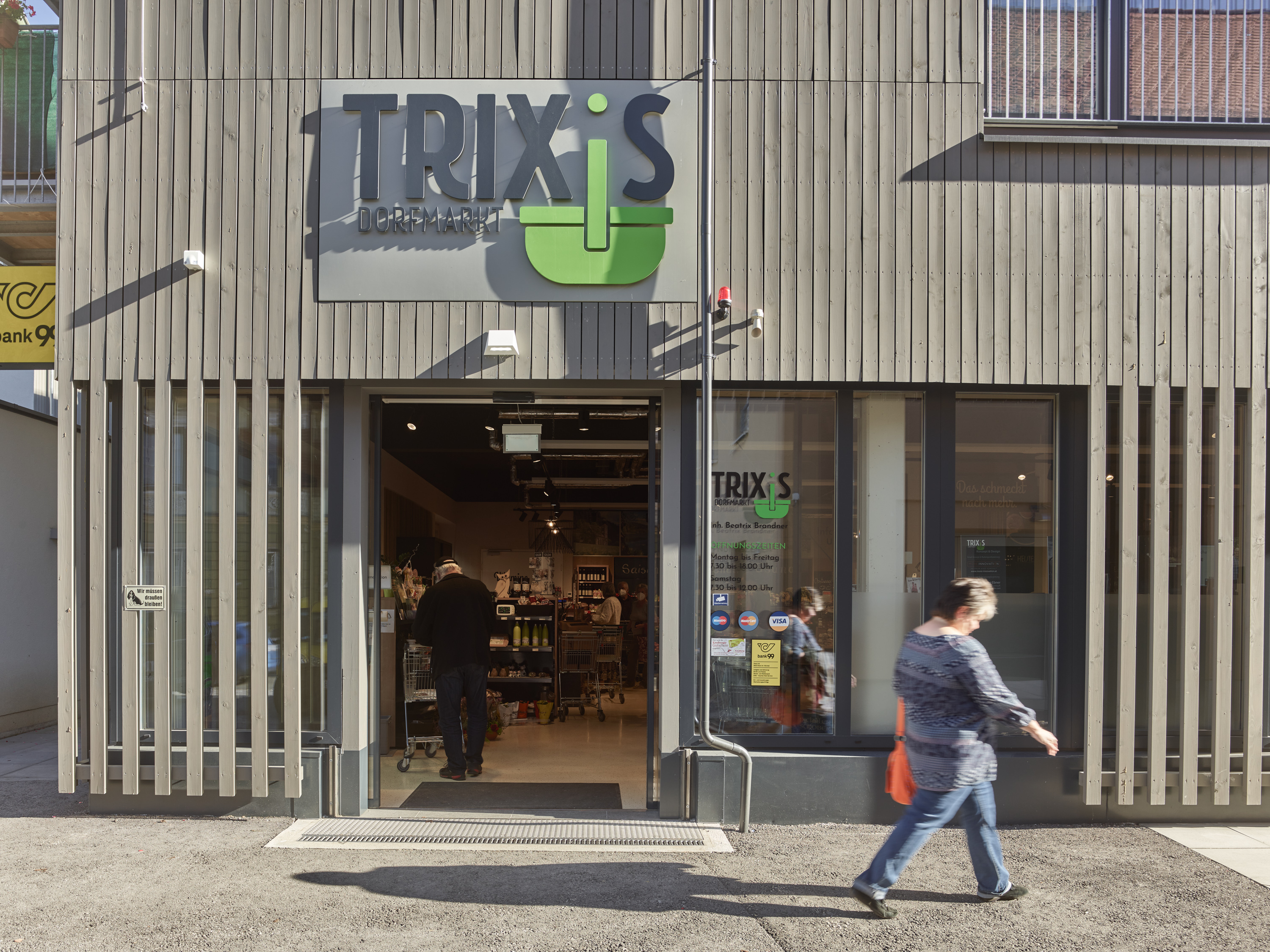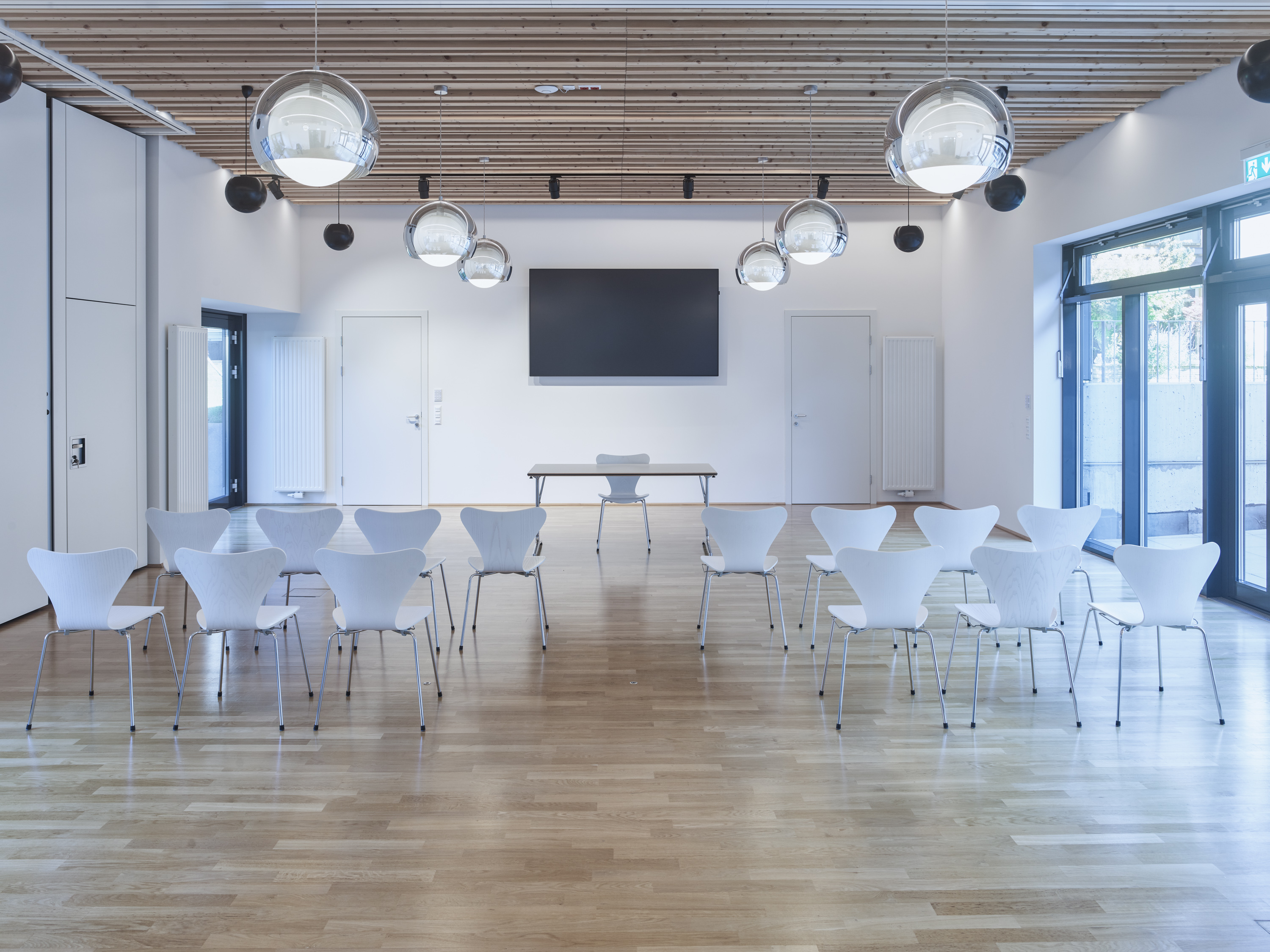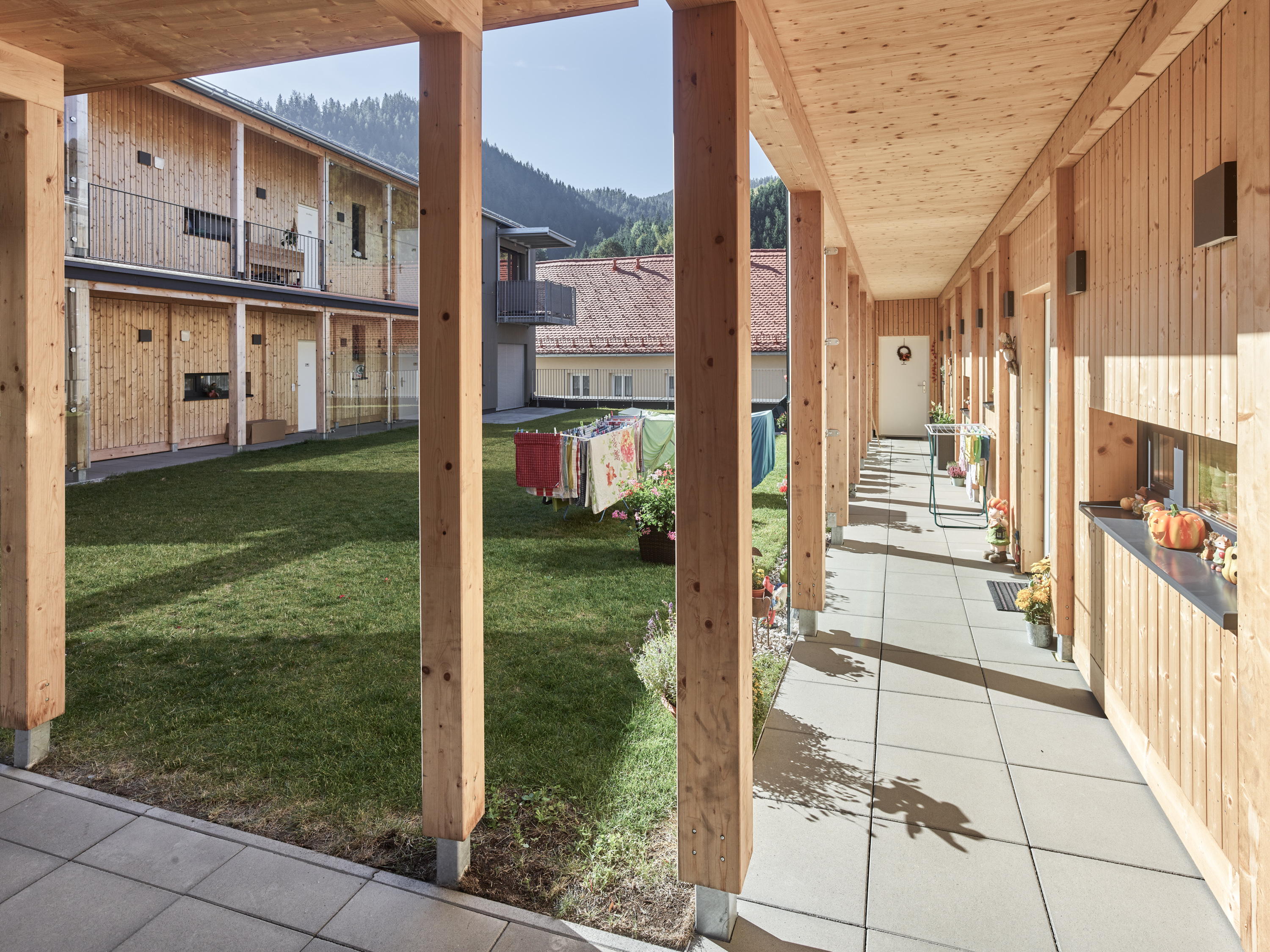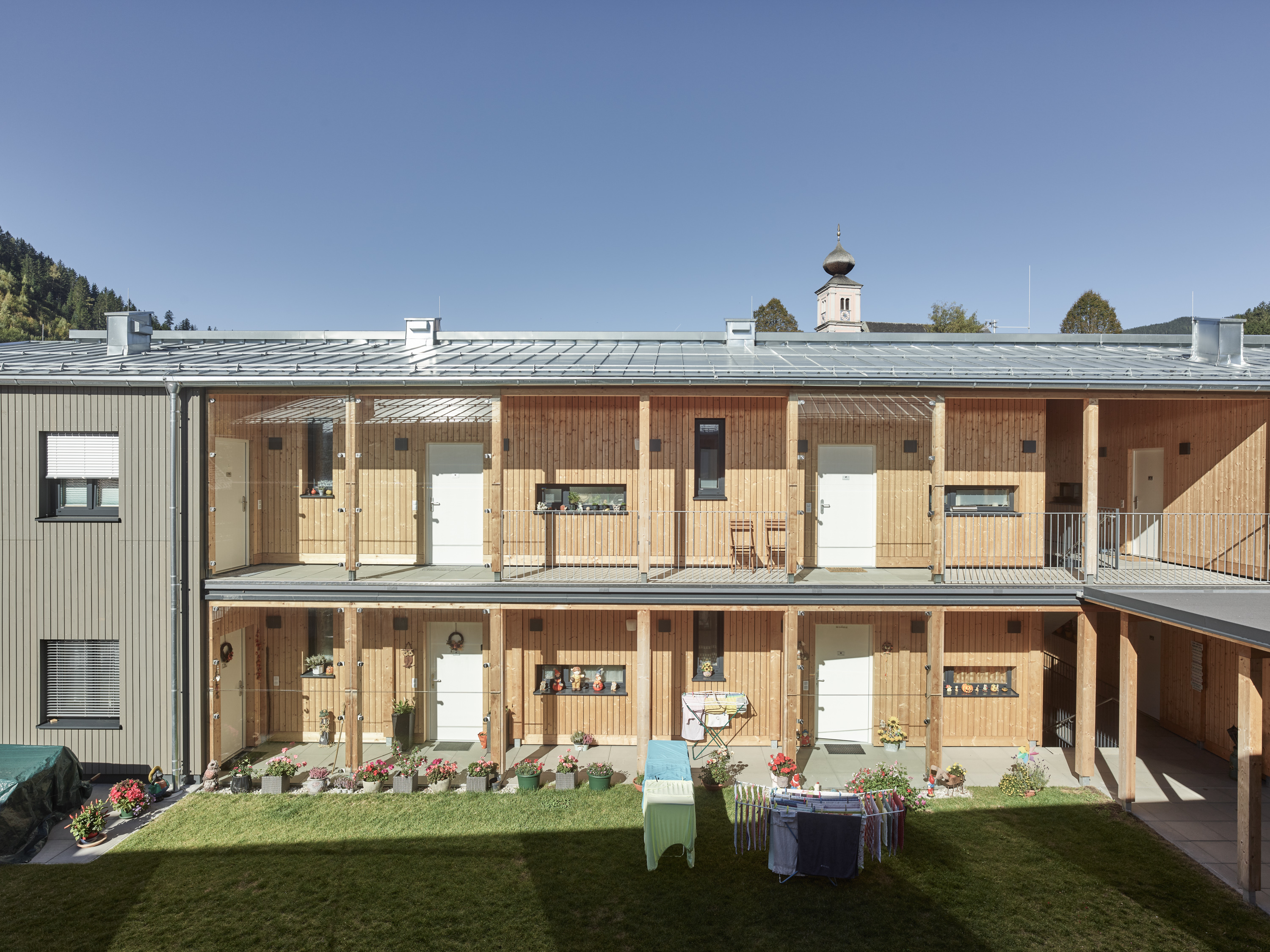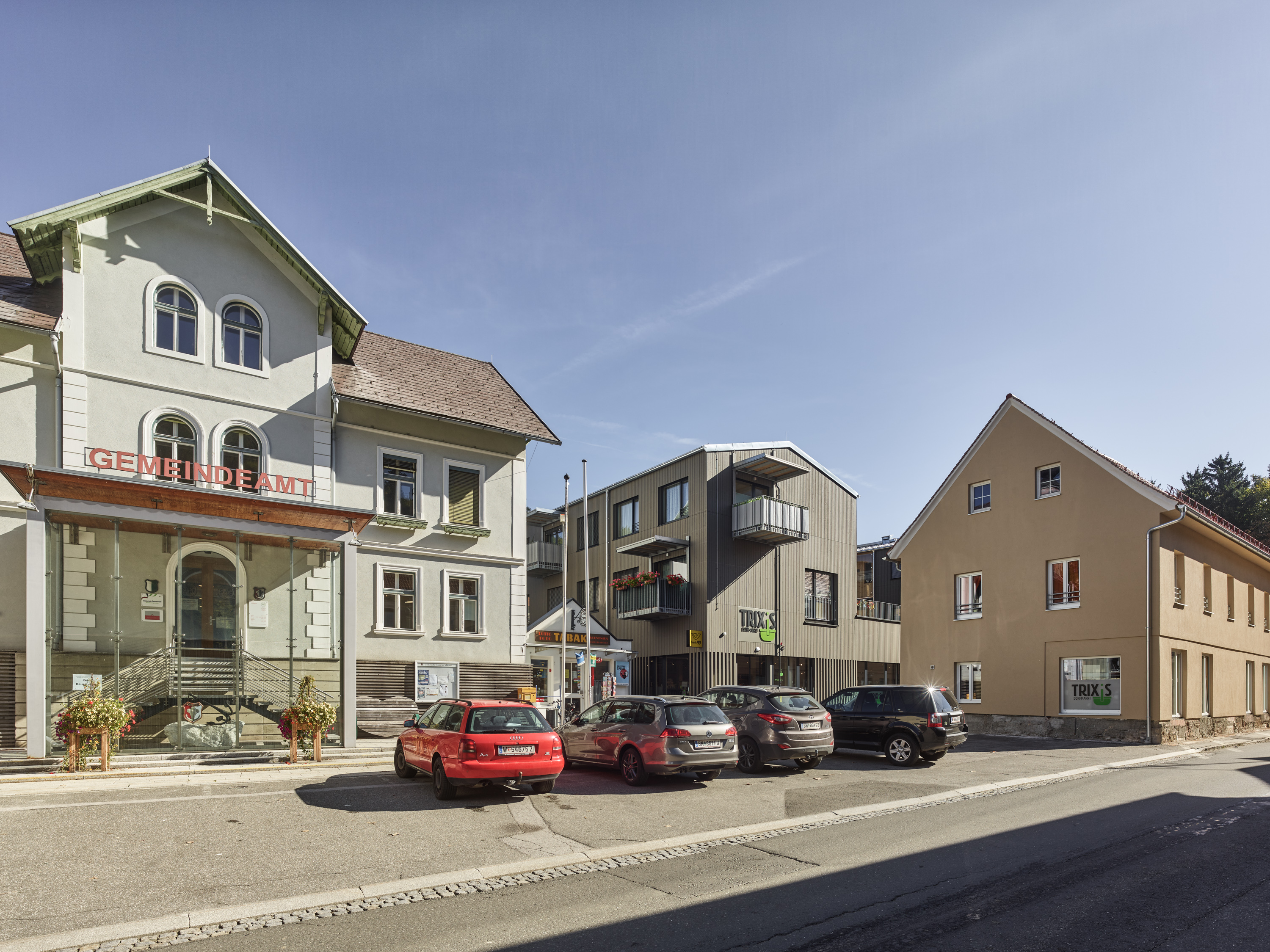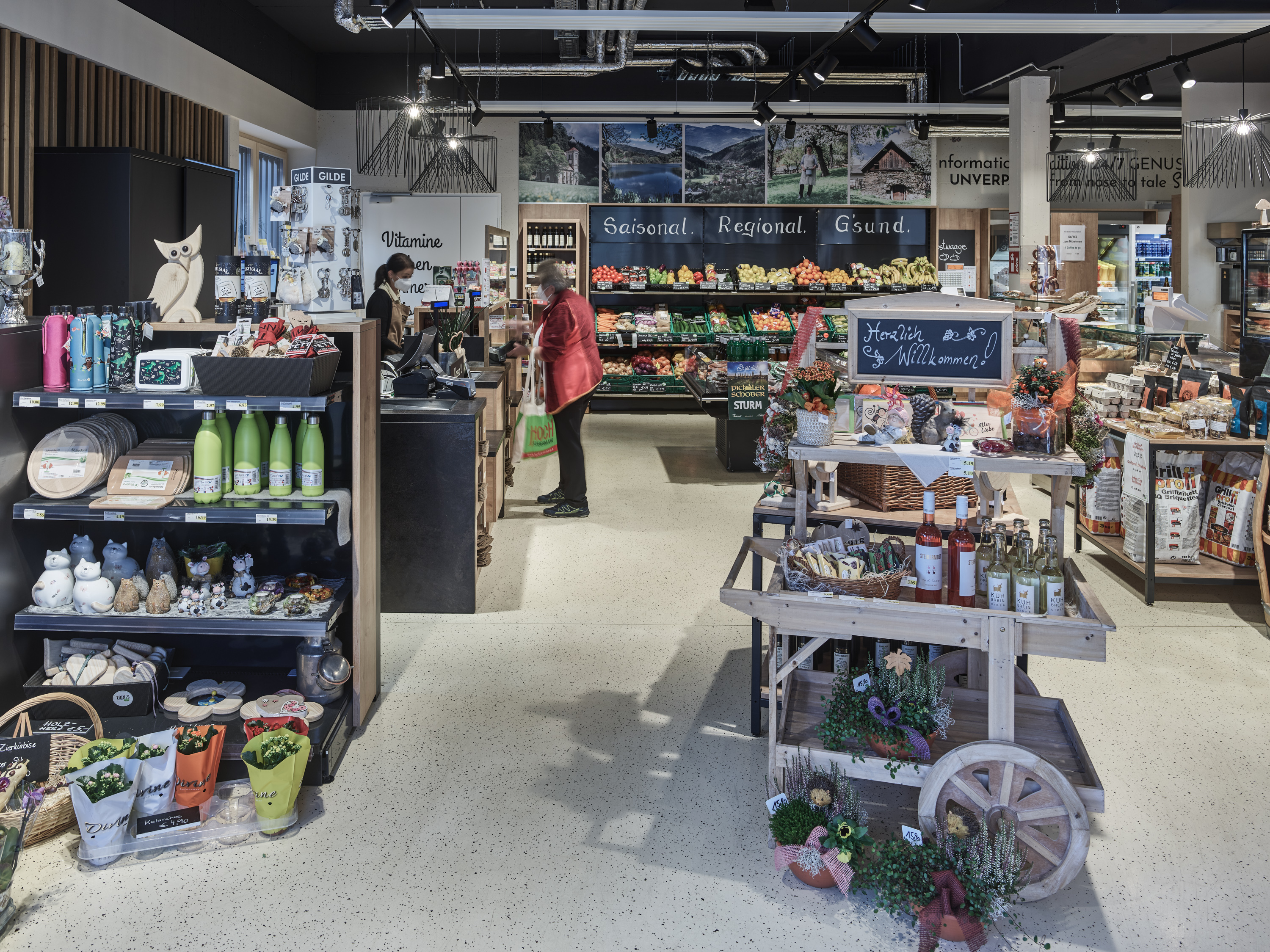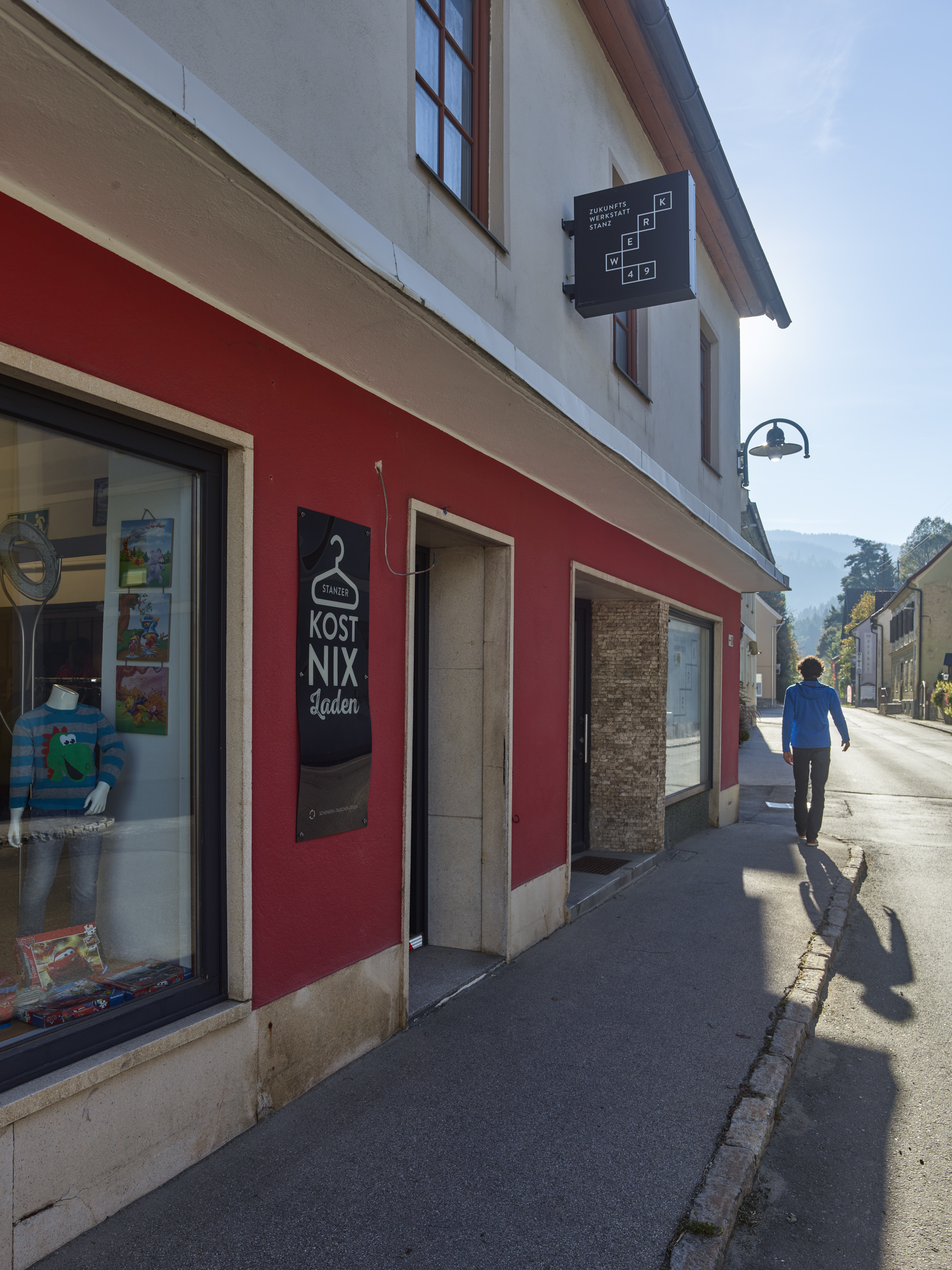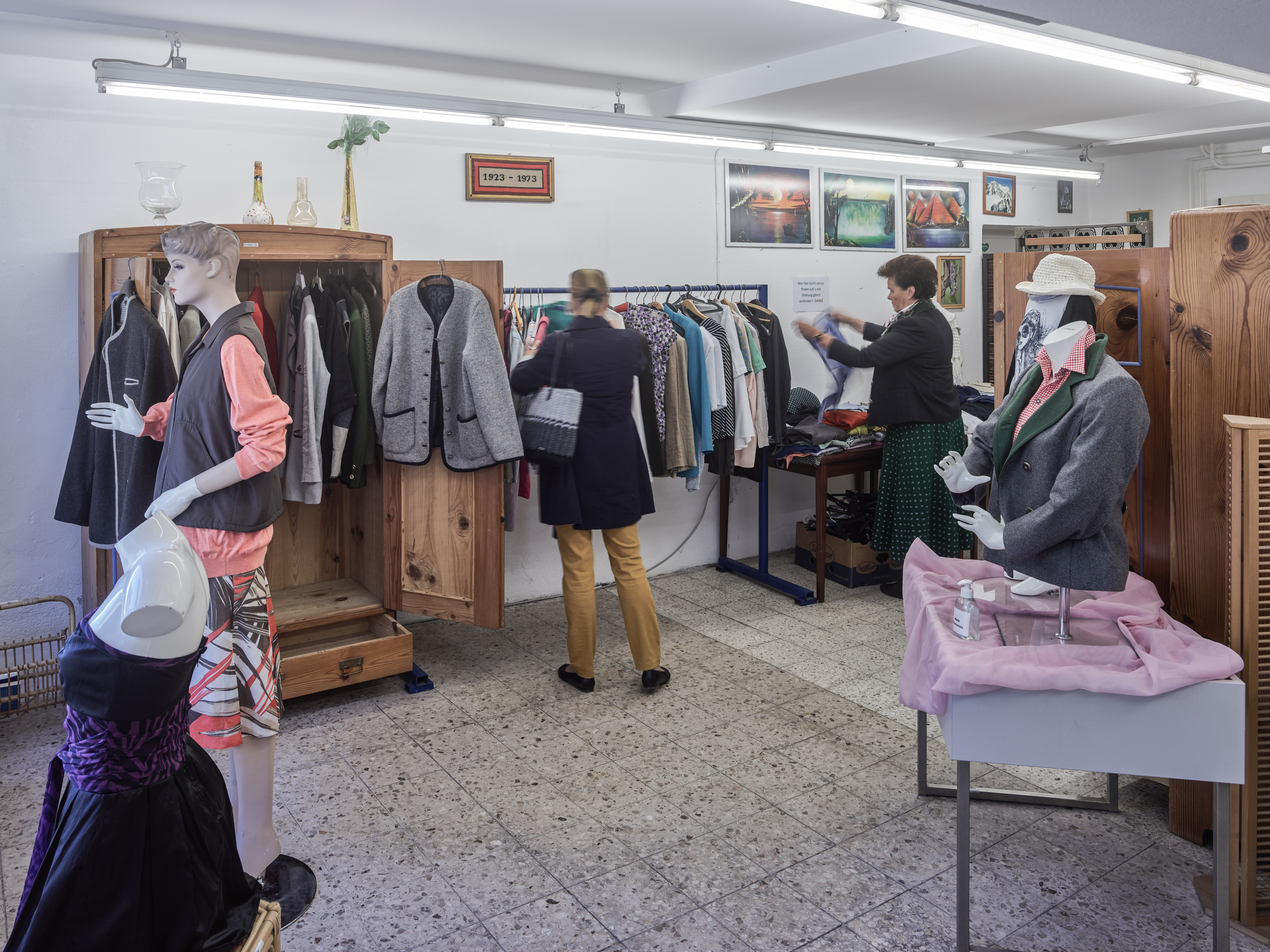Smart Village Stanz
Smart Village Stanz: Plus-Energy District and Revitalizing the Village Center through Co-Creaation
Stanz im Mürztal shows how citizens can transform their village themselves! Through active participation, the village center has been revitalized – with a new local supplier, living space, climate-friendly energy and lively meeting places. Instead of decay, a movement for sustainability and resilience emerged that shows: rural areas can shape the future!
Austria
Village Center Stanz: Stanz 61, 8653 Stanz im Mürztal, Austria.
Prototype level
Yes
Yes
Yes
Yes
‘Preparatory Action on Smart Rural Areas in the 21st Century’ (Smart Rural 21) by the European Commission (DG AGRI)
No
62132: Stanz im Mürztal (AT)
Revitalizing Stanz im Mürztal: A Model for Sustainable Rural Development
Since 2015, the citizens' initiative in Stanz im Mürztal has worked to revitalize the village center through sustainable construction, reducing land consumption, and enhancing quality of life. The Local Agenda 21 process, launched in 2016, established citizen participation as a key principle of municipal development. Today, it functions as a co-creation process, where citizen groups independently implement projects.
Sustainable Construction and Land Conservation
to combat land consumption, Stanz focuses on repurposing vacant buildings instead of expanding into green areas—a critical issue in Austria. The swap-shop (2017) transformed an empty storefront into a circular economy hub. The municipal office renovation created an open, barrier-free civic center, strengthening citizen engagement.
Affordable Housing and Carbon-Neutral Timber Construction: The 2020 timber project integrates Trixis Dorfmarkt and 14 intergenerational apartments. Using local wood, it reduces CO₂ emissions while offering affordable housing.
Energy-Efficient Urban Renewal: The Plus-Energy District in the village center minimizes energy demand through biomass, hydropower, and solar energy. The Stanzertal Energy Community (2022) allows peer-to-peer energy sharing via blockchain, reducing fossil gas dependency.
Cultural Heritage:
Stanz revitalizes existing structures, such as converting the former bank into a house of music, preserving cultural heritage while creating multifunctional spaces.
A Best-Practice Example for Rural Regeneration
As a Smart Rural 21 and 27 model, Stanz showcases sustainable architecture, circular economy, participatory planning, energy innovation, and land-efficient urban renewal, proving that small villages can lead in sustainable development.
Since 2015, the citizens' initiative in Stanz im Mürztal has worked to revitalize the village center through sustainable construction, reducing land consumption, and enhancing quality of life. The Local Agenda 21 process, launched in 2016, established citizen participation as a key principle of municipal development. Today, it functions as a co-creation process, where citizen groups independently implement projects.
Sustainable Construction and Land Conservation
to combat land consumption, Stanz focuses on repurposing vacant buildings instead of expanding into green areas—a critical issue in Austria. The swap-shop (2017) transformed an empty storefront into a circular economy hub. The municipal office renovation created an open, barrier-free civic center, strengthening citizen engagement.
Affordable Housing and Carbon-Neutral Timber Construction: The 2020 timber project integrates Trixis Dorfmarkt and 14 intergenerational apartments. Using local wood, it reduces CO₂ emissions while offering affordable housing.
Energy-Efficient Urban Renewal: The Plus-Energy District in the village center minimizes energy demand through biomass, hydropower, and solar energy. The Stanzertal Energy Community (2022) allows peer-to-peer energy sharing via blockchain, reducing fossil gas dependency.
Cultural Heritage:
Stanz revitalizes existing structures, such as converting the former bank into a house of music, preserving cultural heritage while creating multifunctional spaces.
A Best-Practice Example for Rural Regeneration
As a Smart Rural 21 and 27 model, Stanz showcases sustainable architecture, circular economy, participatory planning, energy innovation, and land-efficient urban renewal, proving that small villages can lead in sustainable development.
Village Centre Densification
Citizen Participation & Co-Creation
Sustainable Buildings & Quality in the Built Environment
Energy Transition & Decarbonization
Affordable Housing
Stanz im Mürztal is a model for sustainable rural regeneration. The key objectives and their implementation include:
1. Land Conservation & Sustainable Village Centre Densification:Austria has one of the highest land consumption rates in Europe. Stanz counters this by reusing existing buildings instead of expanding into green areas. The renovation of the municipal office and the adaptive reuse of a former bank into a house of music preserve built heritage while reducing the need for new land consumption. The swap-shop, an interim-use project in a vacant shop, fosters circular economy principles and strengthens community engagement.
2. Climate-Neutral & Resource-Efficient Construction
The timber construction project (2020) in the village center integrates Trixis Dorfmarkt and 14 intergenerational apartments, prioritizing regional timber to reduce embodied carbon while providing affordable housing. This project was recognized with the Styrian Timber Construction Prize and nominated for the State Prize for Architecture and Sustainability.
3. Energy Transition & Decarbonization
The Plus-Energy District is a leading example of carbon-neutral urban development. Measures include deep energy retrofitting of existing buildings, solar energy integration, and the use of biomass and hydropower. The Stanzertal Energy Community (2022), one of Austria’s first renewable energy communities, enables citizens to share locally generated electricity and optimizing energy flows through load shifting and sector coupling (power2heat).
Exemplary Impact
By participating in the Smart Rural 21 project (www.smartrural21.eu), Stanz im Mürztal has become a pan-European role model for sustainable village development. In November 2021, Stanz hosted the project's second regional workshop, which focused on increasing the resilience of rural communities by strengthening their centers and promoting energy transition.
1. Land Conservation & Sustainable Village Centre Densification:Austria has one of the highest land consumption rates in Europe. Stanz counters this by reusing existing buildings instead of expanding into green areas. The renovation of the municipal office and the adaptive reuse of a former bank into a house of music preserve built heritage while reducing the need for new land consumption. The swap-shop, an interim-use project in a vacant shop, fosters circular economy principles and strengthens community engagement.
2. Climate-Neutral & Resource-Efficient Construction
The timber construction project (2020) in the village center integrates Trixis Dorfmarkt and 14 intergenerational apartments, prioritizing regional timber to reduce embodied carbon while providing affordable housing. This project was recognized with the Styrian Timber Construction Prize and nominated for the State Prize for Architecture and Sustainability.
3. Energy Transition & Decarbonization
The Plus-Energy District is a leading example of carbon-neutral urban development. Measures include deep energy retrofitting of existing buildings, solar energy integration, and the use of biomass and hydropower. The Stanzertal Energy Community (2022), one of Austria’s first renewable energy communities, enables citizens to share locally generated electricity and optimizing energy flows through load shifting and sector coupling (power2heat).
Exemplary Impact
By participating in the Smart Rural 21 project (www.smartrural21.eu), Stanz im Mürztal has become a pan-European role model for sustainable village development. In November 2021, Stanz hosted the project's second regional workshop, which focused on increasing the resilience of rural communities by strengthening their centers and promoting energy transition.
The initiative in Stanz im Mürztal aims to enhance aesthetics and the quality of experience by focusing on design excellence, positive community interactions, and cultural enrichment. Key objectives and their fulfilment include:
1. Architectural Harmony and Design Excellence
Renovating existing structures, such as the municipal office (town hall) and transforming a former bank into a house of music, preserves the village's architectural heritage. The municipal office renovation created an open, barrier-free, and transparent administrative center that facilitates communication between the administration and citizens, enabling new forms of participation. These projects blend traditional aesthetics with modern functionality, creating visually appealing and culturally significant spaces.
2. Creating Inviting Public Spaces
In 2025, a Shared Space will be implemented in the village center, designed to foster social interaction among pedestrians, cyclists, and motorists. This high-quality design aims to revitalize the village center, enhancing the “townscape” and improving the quality of life.
3. Promoting Cultural Activities
Establishing venues like the house of music provides platforms for cultural expression and events. These spaces host concerts, exhibitions, and workshops, enriching the community's cultural fabric and offering residents and visitors meaningful experiences.
Exemplary Impact
Stanz im Mürztal serves as a model for rural communities by demonstrating how strategic design and cultural investment can enhance aesthetics and quality of life. The initiative's emphasis on preserving architectural heritage, creating engaging public spaces, and fostering cultural activities showcases a holistic approach to sustainable and enriching rural development.
1. Architectural Harmony and Design Excellence
Renovating existing structures, such as the municipal office (town hall) and transforming a former bank into a house of music, preserves the village's architectural heritage. The municipal office renovation created an open, barrier-free, and transparent administrative center that facilitates communication between the administration and citizens, enabling new forms of participation. These projects blend traditional aesthetics with modern functionality, creating visually appealing and culturally significant spaces.
2. Creating Inviting Public Spaces
In 2025, a Shared Space will be implemented in the village center, designed to foster social interaction among pedestrians, cyclists, and motorists. This high-quality design aims to revitalize the village center, enhancing the “townscape” and improving the quality of life.
3. Promoting Cultural Activities
Establishing venues like the house of music provides platforms for cultural expression and events. These spaces host concerts, exhibitions, and workshops, enriching the community's cultural fabric and offering residents and visitors meaningful experiences.
Exemplary Impact
Stanz im Mürztal serves as a model for rural communities by demonstrating how strategic design and cultural investment can enhance aesthetics and quality of life. The initiative's emphasis on preserving architectural heritage, creating engaging public spaces, and fostering cultural activities showcases a holistic approach to sustainable and enriching rural development.
The initiative in Stanz im Mürztal is committed to fostering inclusion by prioritizing accessibility, affordability, and participatory governance. Key objectives and their implementation include:
1. Accessibility and Universal Design
The renovation of the municipal office transformed it into an open, barrier-free, and transparent administrative centre, facilitating seamless communication between the administration and citizens, and enabling new forms of participation.
2. Affordable Housing Solutions
The 2020 timber construction project in the village centre introduced 14 intergenerational apartments, providing affordable housing for both young individuals and seniors. This initiative addresses diverse housing needs, fostering a socially inclusive community. Further steps will follow to offer more affordable space in the centre within renovated and new built environment.
3. Participatory Governance and Co-Creation
Initiated in 2016, the Local Agenda 21 process established a framework for citizen participation in municipal development. Approximately 80 engaged residents—representing about 5% of the population—collaborated to create a community vision and implement projects across various sectors. This demonstrates how a small, dedicated group can drive significant change towards sustainability and social cohesion. This co-creation model empowers citizens, granting them decision-making authority and fostering a sense of ownership over local initiatives.
Exemplary Impact
Stanz im Mürztal exemplifies how rural communities can achieve inclusive development by integrating universal design principles, offering affordable housing, and embracing participatory governance. This holistic approach not only enhances accessibility and affordability but also strengthens social cohesion, serving as a model for inclusive rural transformation.
1. Accessibility and Universal Design
The renovation of the municipal office transformed it into an open, barrier-free, and transparent administrative centre, facilitating seamless communication between the administration and citizens, and enabling new forms of participation.
2. Affordable Housing Solutions
The 2020 timber construction project in the village centre introduced 14 intergenerational apartments, providing affordable housing for both young individuals and seniors. This initiative addresses diverse housing needs, fostering a socially inclusive community. Further steps will follow to offer more affordable space in the centre within renovated and new built environment.
3. Participatory Governance and Co-Creation
Initiated in 2016, the Local Agenda 21 process established a framework for citizen participation in municipal development. Approximately 80 engaged residents—representing about 5% of the population—collaborated to create a community vision and implement projects across various sectors. This demonstrates how a small, dedicated group can drive significant change towards sustainability and social cohesion. This co-creation model empowers citizens, granting them decision-making authority and fostering a sense of ownership over local initiatives.
Exemplary Impact
Stanz im Mürztal exemplifies how rural communities can achieve inclusive development by integrating universal design principles, offering affordable housing, and embracing participatory governance. This holistic approach not only enhances accessibility and affordability but also strengthens social cohesion, serving as a model for inclusive rural transformation.
The transformation of Stanz im Mürztal began in 2015, when the citizens' list won the mayor’s office. The goal was clear: democratize municipal governance, dismantle outdated structures, and stop the village’s decline in relevance and infrastructure. To ensure broad participation, a survey was launched to identify the most pressing concerns of residents. This led to the creation of citizen-led working groups focused on village center revitalization, social life, health, energy, and mobility.
From Citizen Priorities to Real Action
Recognizing that words alone would not build trust, the municipality prioritized tangible results. In 2018, construction began on the village center revitalization. By 2020, the first phase was completed, including:
- The opening of Trixis Dorfmarkt, a local supplier strengthening regional value chains.
- 14 new affordable apartments, ensuring that young and elderly residents could remain in the village (center).
- The renovation of the municipal office and town hall, transforming it into an open, transparent administrative center fostering citizen participation.
Seeing real, visible progress, citizens gained trust in the process. It became evident that decisions were not imposed from above but rather co-created with the community.
A Growing Citizen Movement
This trust empowered further initiatives. Today, over 100 citizens actively contribute to projects such as:
- The swap-shop, promoting circular economy principles.
- A community-run e-taxi, improving rural mobility.
- Local renewable energy projects, supporting the transition to a self-sustaining energy system.
Stanz has become a model for citizen-driven rural transformation, proving that through participation, villages can shape their future sustainably and inclusively. This process has also been guided by the Local Agenda 21 initiative: https://www.bmk.gv.at/themen/klima_umwelt/nachhaltigkeit/lokale_agenda21/agenda-vorbilder/2020/stanz.html
From Citizen Priorities to Real Action
Recognizing that words alone would not build trust, the municipality prioritized tangible results. In 2018, construction began on the village center revitalization. By 2020, the first phase was completed, including:
- The opening of Trixis Dorfmarkt, a local supplier strengthening regional value chains.
- 14 new affordable apartments, ensuring that young and elderly residents could remain in the village (center).
- The renovation of the municipal office and town hall, transforming it into an open, transparent administrative center fostering citizen participation.
Seeing real, visible progress, citizens gained trust in the process. It became evident that decisions were not imposed from above but rather co-created with the community.
A Growing Citizen Movement
This trust empowered further initiatives. Today, over 100 citizens actively contribute to projects such as:
- The swap-shop, promoting circular economy principles.
- A community-run e-taxi, improving rural mobility.
- Local renewable energy projects, supporting the transition to a self-sustaining energy system.
Stanz has become a model for citizen-driven rural transformation, proving that through participation, villages can shape their future sustainably and inclusively. This process has also been guided by the Local Agenda 21 initiative: https://www.bmk.gv.at/themen/klima_umwelt/nachhaltigkeit/lokale_agenda21/agenda-vorbilder/2020/stanz.html
While the comprehensive involvement of local actors has already been described in detail, Stanz im Mürztal places particular emphasis on national and international exchange in order to learn from others and share its own experiences. In the last five years, numerous national and international delegations have visited Stanz to study the project approaches. At the same time, representatives of the municipality were invited to report on their experiences in a series of lectures. Here is a selection of these activities:
• Communicating Roots: Co-learning Methods for Improving Resilience Management in Rural Areas. Workshop by Rainer Rosegger: 26. 04. 2023, Stanz im Mürztal
• European Symposium of Small Communities, presentation: Smart Village Stanz by Rainer Rosegger. June 23, 2023, Portugal (PT), organized by the municipality of Vila Boa do Bispo
• International Seminar Good practices of innovation and social entrepreneurship Regional, national and international experiences. Lecture Rainer Rosegger: Smart Village Stanz May 2023, Portugal (PT), organized by the University of Beira Interior Covilha
• Decide Project: How to REPLICATE the best practices among Energy Communities and Collective Actions? Workshop von Rainer Rosegger: Social Innovation in Stanz im Mürztal 24. 5. 2022, Graz
• Building Culture Tour 2023 with excursion to Stanz im Mürztal with approx. 40 participants from politics and administration of Styrian municipalities as well as representatives of regional management and the province of Styria. May 2023
• Municipality of Anger/Austria (lecture in Anger and visit by a delegation to Stanz)
• Municipality of Bad Aussee/Austria (lecture in Bad Aussee as part of the Capital of Culture 2024 and visit by a delegation to Stanz)
• Visits by a delegation from the Czech Republic, from Estonia, visit from 16 European SmartRural21 communities in Stanz
• Lecture as part of an event at the Landluft Association in Stainz/Austria
• Communicating Roots: Co-learning Methods for Improving Resilience Management in Rural Areas. Workshop by Rainer Rosegger: 26. 04. 2023, Stanz im Mürztal
• European Symposium of Small Communities, presentation: Smart Village Stanz by Rainer Rosegger. June 23, 2023, Portugal (PT), organized by the municipality of Vila Boa do Bispo
• International Seminar Good practices of innovation and social entrepreneurship Regional, national and international experiences. Lecture Rainer Rosegger: Smart Village Stanz May 2023, Portugal (PT), organized by the University of Beira Interior Covilha
• Decide Project: How to REPLICATE the best practices among Energy Communities and Collective Actions? Workshop von Rainer Rosegger: Social Innovation in Stanz im Mürztal 24. 5. 2022, Graz
• Building Culture Tour 2023 with excursion to Stanz im Mürztal with approx. 40 participants from politics and administration of Styrian municipalities as well as representatives of regional management and the province of Styria. May 2023
• Municipality of Anger/Austria (lecture in Anger and visit by a delegation to Stanz)
• Municipality of Bad Aussee/Austria (lecture in Bad Aussee as part of the Capital of Culture 2024 and visit by a delegation to Stanz)
• Visits by a delegation from the Czech Republic, from Estonia, visit from 16 European SmartRural21 communities in Stanz
• Lecture as part of an event at the Landluft Association in Stainz/Austria
In Stanz the local citizens have been connected via different formats, project activities and events to various experts and professionals to develop the idea of climate neutral energy system, sustainable renovated and built environment, local business models and community building.
First of all a link to existing and new energy service companies and suppliers as well as grid operators was established to follow up on the idea of setting up a local energy community and a electronic based e-token system as local benefit currency. The process is ongoing, the energy community is founded and the e-token system is currently under development with national service providers.
Second there was and is an intensive cooperation with energy system planners and architects to develop and design a new densification and reactivation of the center of Stanz. This cooperation led to both, building renovation and sustainable thinking in the local energy system development focusing on sector coupling technologies.
Third there has been always the interaction with representative of research, culture and social sciences to reflect the technological developments in the light of other societal and culture-based tendencies. In local agenda 21 and different research as well as film projects around Stanz activities it was and is still possible to gain additional benefits from other professions and ideas.
First of all a link to existing and new energy service companies and suppliers as well as grid operators was established to follow up on the idea of setting up a local energy community and a electronic based e-token system as local benefit currency. The process is ongoing, the energy community is founded and the e-token system is currently under development with national service providers.
Second there was and is an intensive cooperation with energy system planners and architects to develop and design a new densification and reactivation of the center of Stanz. This cooperation led to both, building renovation and sustainable thinking in the local energy system development focusing on sector coupling technologies.
Third there has been always the interaction with representative of research, culture and social sciences to reflect the technological developments in the light of other societal and culture-based tendencies. In local agenda 21 and different research as well as film projects around Stanz activities it was and is still possible to gain additional benefits from other professions and ideas.
The local council of Stanz, together with committed citizens, has succeeded in creating a new village culture that is supported by the population. By involving the relevant interest groups, measures have been taken that make Stanz more livable and at the same time increase local added value through sustainable energy supply and economic management. Both are prerequisites for long-term attractiveness as a living space.
The first main goal was to increase the supply of renewable energy sources, which was around 30%, to 100%. This has been implemented on a pilot basis with measures to promote energy efficiency and flexible use of these energy sources via sector coupling focus as well as the development of multipliable, innovative business models for financing. At the same time, the optimization and expansion of the local energy networks (heat and electricity) in the town center as well as solutions to increase their resilience are underway.
The second main goal was the revitalization and enlivenment of the town center. Through new approaches to saving space and compatible densification, building on previous activities, central areas are increasingly used for living and business. The reduction in energy consumption focused on the surveys for the preparation and planning of the renovation of some existing buildings including the house of the musicians.
The first main goal was to increase the supply of renewable energy sources, which was around 30%, to 100%. This has been implemented on a pilot basis with measures to promote energy efficiency and flexible use of these energy sources via sector coupling focus as well as the development of multipliable, innovative business models for financing. At the same time, the optimization and expansion of the local energy networks (heat and electricity) in the town center as well as solutions to increase their resilience are underway.
The second main goal was the revitalization and enlivenment of the town center. Through new approaches to saving space and compatible densification, building on previous activities, central areas are increasingly used for living and business. The reduction in energy consumption focused on the surveys for the preparation and planning of the renovation of some existing buildings including the house of the musicians.
At the beginning, the needs of the citizens were the main focus. Through surveys and workshops, we identified the most pressing concerns, on the basis of which technical planning with active citizen participation followed.
A comprehensive vacancy and building analysis in the village center laid the foundation for further steps. We then carried out a detailed analysis of energy production, consumption, load profiles and building use in both the village center and the entire municipality of Stanz. These analyses made it possible to plan targeted measures to improve the energy infrastructure.
Later, activities within the energy infrastructure and networks began, such as the construction of a new local biomass heating network, wind turbines, planning of PV systems and the revitalization of existing hydropower in order to advance the transition.
At the same time, the use of digitalization such as the expansion of smart meters, their actual data transfer and resident participation developed new concepts for making energy supply and consumption more flexible, as well as supporting business models. A new building as “house of the musicians” was planned in the town center with user participation. Over two years, real data from networks and buildings were recorded and evaluated, and social scientific information was collected in the newly founded energy community. These were the basis for new control concepts, optimizations and energy use by citizens, which are still in improvement loop.
Fundamental is the interweaving of technical solutions with social innovation. Due to the successful activation and participation of the “citizen forces” in shaping their own living environment, the acceptance of the (technical) solutions was easier to implement using a “bottom-up approach” than with the common “expert top-down”. This will be further used to increase awareness and activities along climate neutral future paths.
A comprehensive vacancy and building analysis in the village center laid the foundation for further steps. We then carried out a detailed analysis of energy production, consumption, load profiles and building use in both the village center and the entire municipality of Stanz. These analyses made it possible to plan targeted measures to improve the energy infrastructure.
Later, activities within the energy infrastructure and networks began, such as the construction of a new local biomass heating network, wind turbines, planning of PV systems and the revitalization of existing hydropower in order to advance the transition.
At the same time, the use of digitalization such as the expansion of smart meters, their actual data transfer and resident participation developed new concepts for making energy supply and consumption more flexible, as well as supporting business models. A new building as “house of the musicians” was planned in the town center with user participation. Over two years, real data from networks and buildings were recorded and evaluated, and social scientific information was collected in the newly founded energy community. These were the basis for new control concepts, optimizations and energy use by citizens, which are still in improvement loop.
Fundamental is the interweaving of technical solutions with social innovation. Due to the successful activation and participation of the “citizen forces” in shaping their own living environment, the acceptance of the (technical) solutions was easier to implement using a “bottom-up approach” than with the common “expert top-down”. This will be further used to increase awareness and activities along climate neutral future paths.
Stanz remains highly active in comparison to other municipality of this size and population, and the change of mayor at the beginning of 2024 has not changed this - the next projects and activities have already been decided.
The next research projects are aimed at expanding, networking and supraregionally expanding the energy community, detailed planning for the use of sector coupling and load balancing with integration of wind turbines in the municipality, expansion of the municipality's own infrastructure, introduction of the e-token system for the development of the energy currency “Stanzertaler”.
Stanz was one of the plaintiffs against the state of Austria for failing to implement measures against climate change (the centre of Stanz is largely situated in the “red zone” with high flood risk). The lawsuit has now been before the European Court of Justice since December 2023.
All these learnings and process innovations are highly relevant for similar communities and multipliable across Europe. The example of Stanz and their established processes will make them more resilient in both directions, the society and its engagement as well as the technological and innovation driven development of such municipalities.
The next research projects are aimed at expanding, networking and supraregionally expanding the energy community, detailed planning for the use of sector coupling and load balancing with integration of wind turbines in the municipality, expansion of the municipality's own infrastructure, introduction of the e-token system for the development of the energy currency “Stanzertaler”.
Stanz was one of the plaintiffs against the state of Austria for failing to implement measures against climate change (the centre of Stanz is largely situated in the “red zone” with high flood risk). The lawsuit has now been before the European Court of Justice since December 2023.
All these learnings and process innovations are highly relevant for similar communities and multipliable across Europe. The example of Stanz and their established processes will make them more resilient in both directions, the society and its engagement as well as the technological and innovation driven development of such municipalities.
The main global challenges that Stanz im Mürztal is addressing are:
1. Combating climate change: By implementing adaptation measures, the community is becoming more resilient to risks. These include the expansion of the biomass district heating network, the integration of energy storage devices such as batteries and tanks, and the use of grid flexibilities, communicated via the energy community or municipal channels.
2. Combating urban sprawl and strengthening local centers: The trend towards urban sprawl will be stopped by using existing infrastructure and promoting local centers. This helps to strengthen the community and improve the quality of life.
3. Combating the individualization of society: Through a variety of activities, local citizens and interest groups are integrated and successfully familiarized with new technical, social and cultural developments from "outside".
These measures aim to increase the resilience of the community and promote social cohesion.
1. Combating climate change: By implementing adaptation measures, the community is becoming more resilient to risks. These include the expansion of the biomass district heating network, the integration of energy storage devices such as batteries and tanks, and the use of grid flexibilities, communicated via the energy community or municipal channels.
2. Combating urban sprawl and strengthening local centers: The trend towards urban sprawl will be stopped by using existing infrastructure and promoting local centers. This helps to strengthen the community and improve the quality of life.
3. Combating the individualization of society: Through a variety of activities, local citizens and interest groups are integrated and successfully familiarized with new technical, social and cultural developments from "outside".
These measures aim to increase the resilience of the community and promote social cohesion.
The New European Bauhaus (NEB) values will be further developed in the Stanz initiative:
Sustainability through the consistent implementation of the plan to further strengthen the town center through attractive redevelopment, densification and the implementation of a shared space. To convert the local energy system to a system with 100% renewable energies, which was planned together with experts but with strong local citizen involvement.
Inclusive by involving all interest and social groups via participatory events and activities assisting the overall spatial energy, building and natural resource allocation planning. Implementing space and affordable housing for different social groups bringing them together in new built center areas.
Beautiful in building on existing and natural influenced structures and qualities evolved over hundreds of years in Stanz and strengthen its historical grown shape for the future. The transdisciplinary and participatory approach of planning and implementing new elements into these historical grown structures supports the innovative character of the municipality.
Sustainability through the consistent implementation of the plan to further strengthen the town center through attractive redevelopment, densification and the implementation of a shared space. To convert the local energy system to a system with 100% renewable energies, which was planned together with experts but with strong local citizen involvement.
Inclusive by involving all interest and social groups via participatory events and activities assisting the overall spatial energy, building and natural resource allocation planning. Implementing space and affordable housing for different social groups bringing them together in new built center areas.
Beautiful in building on existing and natural influenced structures and qualities evolved over hundreds of years in Stanz and strengthen its historical grown shape for the future. The transdisciplinary and participatory approach of planning and implementing new elements into these historical grown structures supports the innovative character of the municipality.

